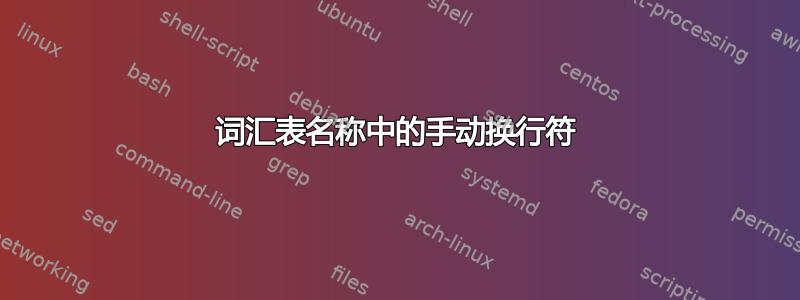
我在这里找到了一种定义我自己的词汇表风格的方法:
\newglossarystyle{superglossarystyle}
{
\setglossarystyle{super}
\renewenvironment{theglossary}
{
\tablehead{}
\tabletail{}
\begin{supertabular}{rp{\glsdescwidth}}
}
{
\end{supertabular}
}
}
%
\setglossarystyle{superglossarystyle}
如何在name-field 中手动断行\newglossaryentry?
现在的情况:
ParameterA,ParameterB This is the description of ParameterA and ParameterB,
that is long and automatically wraps.
ParameterC This is the description of ParameterC, that is long
and automatically wraps.
它看起来应该是这样的:
ParameterA,
ParameterB This is the description of ParameterA and ParameterB,
that is long and automatically wraps.
ParameterC This is the description of ParameterC, that is long
and automatically wraps.
我尝试添加\\,\linebreak,\tabbreak“等”作为换行符,但没有成功。
\documentclass[pdftex,a4paper,oneside,12pt,halfparskip]{scrbook}
\usepackage[]{amsmath,amssymb}
\usepackage[ngerman]{babel}
\usepackage[T1]{fontenc}
\usepackage[utf8]{inputenc}
\usepackage[a4paper,top=3.6cm,bottom=3.6cm,left=3.6cm,right=3.6cm]{geometry}
\usepackage[]{glossaries}
\newglossarystyle{superglossarystyle}
{
\setglossarystyle{super}
\renewenvironment{theglossary}
{
\tablehead{}
\tabletail{}
\begin{supertabular}{cp{\glsdescwidth}}
}
{
\end{supertabular}
}
}
\setglossarystyle{superglossarystyle}
\makeglossaries
\newglossaryentry{pab}
{
name = {$\boldsymbol{ParameterA},\boldsymbol{ParameterB}$} ,
description = {This is the description of ParameterA and ParameterB, that is long and automatically wraps} ,
}
\newglossaryentry{pc}
{
name = {$\boldsymbol{ParameterC}$} ,
description = {This is the description of ParameterC, that is long and automatically wraps.} ,
}
\begin{document}
\glsaddallunused\printglossaries
\end{document}
答案1
标准列说明符为l、r和cp{长度}。您可以使用array包,但我认为在这种情况下不需要这样做,因为您可以使用 调整段落对齐方式\raggedleft。定义新的词汇表样式时,考虑该样式的简化版本会有所帮助。在基本层面上,样式需要采用以下形式:
\documentclass{article}
\begin{document}
\begin{tabular}{p{2cm}p{4cm}}
\raggedleft A. & some text\\
\raggedleft AA. & some more text\\
\raggedleft AAA. & some more text
\end{tabular}
\end{document}
它具有右对齐的段落样式的第一列。

现在测试一下如果ParameterA,ParameterB添加会发生什么:
\documentclass{article}
\begin{document}
\begin{tabular}{p{2cm}p{4cm}}
\raggedleft A. & some text\\
\raggedleft AA. & some more text\\
\raggedleft AAA. & some more text\\
\raggedleft ParameterA,ParameterB & some text
\end{tabular}
\end{document}
这没有换行,因为 TeX 无法插入换行符,所以结果相当丑陋。

相反,你需要为 TeX 提供一些范围来在逗号处断行:
\documentclass{article}
\newcommand{\comma}{,\penalty \exhyphenpenalty}
\begin{document}
\begin{tabular}{p{2cm}p{4cm}}
\raggedleft A. & some text\\
\raggedleft AA. & some more text\\
\raggedleft ParameterA\comma ParameterB & some text
\end{tabular}
\end{document}
TeX 现在可以打破这一行了:

2cm这里我使用和硬编码了列宽4cm,但glossaries包为第二列定义了一个长度,称为\glsdescwidth。您可以为第一列定义另一个长度:
\newlength\glsnamewidth
您需要根据文档的需要设置此值。例如:
\setlength{\glsnamewidth}{3cm}
或者
\setlength{\glsnamewidth}{0.3\hsize}
新的词汇表样式可以定义为:
\newglossarystyle{superglossarystyle}
{%
\setglossarystyle{super}%
\renewenvironment{theglossary}%
{%
\tablehead{}%
\tabletail{}%
\begin{supertabular}{p{\glsnamewidth}p{\glsdescwidth}}%
}%
{%
\end{supertabular}%
}%
\renewcommand{\glossentry}[2]{%
\raggedleft
\glsentryitem{##1}\glstarget{##1}{\glossentryname{##1}} &
\glossentrydesc{##1}\glspostdescription\space ##2\tabularnewline
}%
}
完整示例为:
\documentclass[pdftex,a4paper,oneside,12pt,halfparskip]{scrbook}
\usepackage[]{amsmath,amssymb}
\usepackage[ngerman]{babel}
\usepackage[T1]{fontenc}
\usepackage[utf8]{inputenc}
\usepackage[a4paper,top=3.6cm,bottom=3.6cm,left=3.6cm,right=3.6cm]{geometry}
\usepackage[]{glossaries}
\newcommand{\comma}{,\penalty \exhyphenpenalty}
\newlength\glsnamewidth
\setlength{\glsnamewidth}{0.3\hsize}
\newglossarystyle{superglossarystyle}
{%
\setglossarystyle{super}%
\renewenvironment{theglossary}%
{%
\tablehead{}%
\tabletail{}%
\begin{supertabular}{p{\glsnamewidth}p{\glsdescwidth}}%
}%
{%
\end{supertabular}%
}%
\renewcommand{\glossentry}[2]{%
\raggedleft
\glsentryitem{##1}\glstarget{##1}{\glossentryname{##1}} &
\glossentrydesc{##1}\glspostdescription\space ##2\tabularnewline
}%
}
\setglossarystyle{superglossarystyle}
\makeglossaries
\newglossaryentry{pab}
{
name =
{$\boldsymbol{ParameterA}\comma\boldsymbol{ParameterB}$} ,
description = {This is the description of ParameterA and
ParameterB, that is long and automatically wraps} ,
}
\newglossaryentry{pc}
{
name = {$\boldsymbol{ParameterC}$} ,
description = {This is the description of ParameterC, that is
long and automatically wraps.} ,
}
\begin{document}
\glsaddallunused\printglossaries
\end{document}
生成结果:



